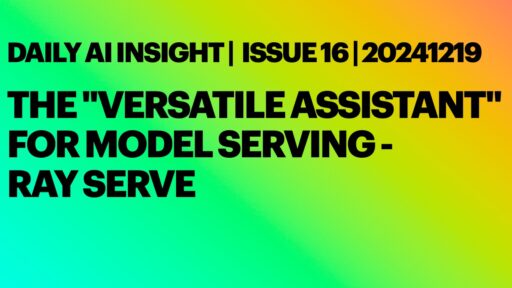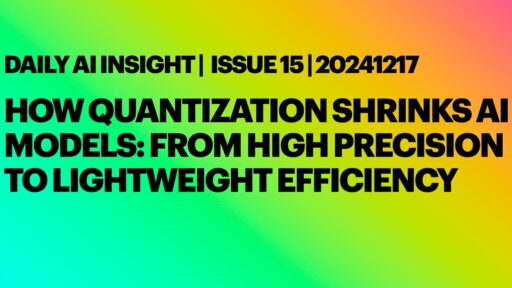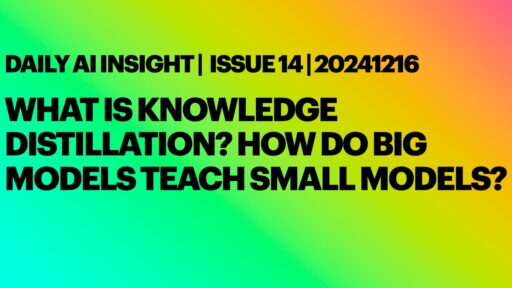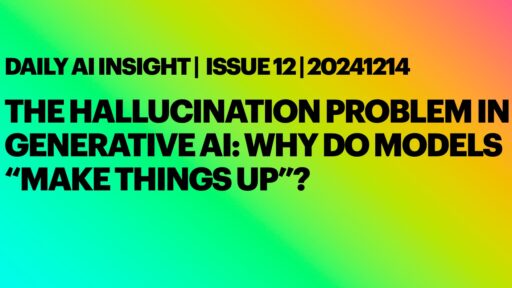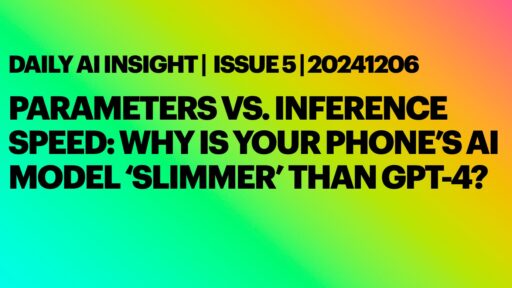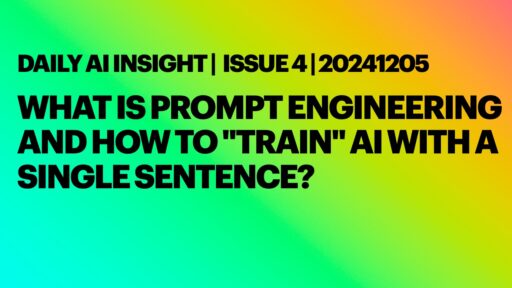Transformers are changing the AI landscape, and it all began with the groundbreaking paper "Attention is All You Need." Today, I explore the Introduction and Background sections of the paper, uncovering the limitations of traditional RNNs, the power of self-attention, and the importance of parallelization in modern AI models. Dive in to learn how Transformers revolutionized sequence modeling and transduction tasks! 1. Introduction Sentence 1: Recurrent neural networks, long short-term memory [13] and gated recurrent [7] neural networks in particular, have been firmly established as state-of-the-art approaches in sequence modeling and transduction problems such as language modeling and machine translation [35, 2, 5]. Explanation (like for an elementary school student): There are special types of AI models called Recurrent Neural Networks (RNNs) that are like people who can remember things from the past while working on something new. Long Short-Term Memory (LSTM) and Gated Recurrent Units (GRUs) are improved versions of RNNs. These models are the best performers (state-of-the-art) for tasks where you need to process sequences, like predicting the next word in a sentence (language modeling) or translating text from one language to another (machine translation). Key terms explained: Recurrent Neural Networks (RNNs): Models designed to handle sequential data (like sentences, time series). Analogy: Imagine reading a book where each sentence depends on the one before it. An RNN processes the book one sentence at a time, remembering earlier ones. Further Reading: RNNs on Wikipedia Long Short-Term Memory (LSTM): A type of RNN that solves the problem of forgetting important past information. Analogy: LSTMs are like a memory-keeper that…
Below is a comprehensive table of key terms used in the paper "Attention is All You Need," along with their English and Chinese translations. Where applicable, links to external resources are provided for further reading. English Term Chinese Translation Explanation Link Encoder 编码器 The component that processes input sequences. Decoder 解码器 The component that generates output sequences. Attention Mechanism 注意力机制 Measures relationships between sequence elements. Attention Mechanism Explained Self-Attention 自注意力 Focuses on dependencies within a single sequence. Masked Self-Attention 掩码自注意力 Prevents the decoder from seeing future tokens. Multi-Head Attention 多头注意力 Combines multiple attention layers for better modeling. Positional Encoding 位置编码 Adds positional information to embeddings. Residual Connection 残差连接 Shortcut connections to improve gradient flow. Layer Normalization 层归一化 Stabilizes training by normalizing inputs. Layer Normalization Details Feed-Forward Neural Network (FFNN) 前馈神经网络 Processes data independently of sequence order. Feed-Forward Networks in NLP Recurrent Neural Network (RNN) 循环神经网络 Processes sequences step-by-step, maintaining state. RNN Basics Convolutional Neural Network (CNN) 卷积神经网络 Uses convolutions to extract features from input data. CNN Overview Parallelization 并行化 Performing multiple computations simultaneously. BLEU (Bilingual Evaluation Understudy) 双语评估替代 A metric for evaluating the accuracy of translations. Understanding BLEU This table provides a solid foundation for understanding the technical terms used in the "Attention is All You Need" paper. If you have questions or want to dive deeper into any term, the linked resources are a great place to start!
Today marks the beginning of my adventure into one of the most groundbreaking papers in AI for transformer: "Attention is All You Need" by Vaswani et al. If you’ve ever been curious about how modern language models like GPT or BERT work, this is where it all started. It’s like diving into the DNA of transformers — the core architecture behind many AI marvels today. What I’ve learned so far has completely blown my mind, so let’s break it down step by step. I’ll keep it fun, insightful, and bite-sized so you can learn alongside me! From today, I plan to study one or two pages of this paper daily and share my learning highlights right here. Day 1: The Abstract The abstract of "Attention is All You Need" sets the stage for the paper’s groundbreaking contributions. Here’s what I’ve uncovered today about the Transformer architecture: The Problem with Traditional Models: Most traditional sequence models rely on Recurrent Neural Networks (RNNs) or Convolutional Neural Networks (CNNs). These models have limitations: RNNs are slow due to sequential processing and lack parallelization. CNNs struggle to capture long-range dependencies effectively. Transformer’s Proposal: The paper introduces the Transformer, a new architecture that uses only Attention Mechanisms while completely removing recurrence and convolution. This approach makes transformers faster and more efficient. Experimental Results: On WMT 2014 English-German translation, the Transformer achieves a BLEU score of 28.4, surpassing previous models by over 2 BLEU points. WMT (Workshop on Machine Translation) is a benchmark competition for translation models, and this task involves translating English text into German.…
Ray Serve is a cutting-edge model serving library built on the Ray framework, designed to simplify and scale AI model deployment. Whether you’re chaining models in sequence, running them in parallel, or dynamically routing requests, Ray Serve excels at handling complex, distributed inference pipelines. Unlike Ollama or FastAPI, it combines ease of use with powerful scaling, multi-model management, and Pythonic APIs. In this post, we’ll explore how Ray Serve compares to other solutions and why it stands out for large-scale, multi-node AI serving. Before Introducing Ray Serve, We Need to Understand Ray What is Ray? Ray is an open-source distributed computing framework that provides the core tools and components for building and running distributed applications. Its goal is to enable developers to easily scale single-machine programs to distributed environments, supporting high-performance tasks such as distributed model training, large-scale data processing, and distributed inference. Core Modules of Ray Ray Core The foundation of Ray, providing distributed scheduling, task execution, and resource management. Allows Python functions to be seamlessly transformed into distributed tasks using the @ray.remote decorator. Ideal for distributed data processing and computation-intensive workloads. Ray Libraries Built on top of Ray Core, these are specialized tools designed for specific tasks. Examples include: Ray Tune: For hyperparameter search and experiment optimization. Ray Train: For distributed model training. Ray Serve: For distributed model serving. Ray Data: For large-scale data and stream processing. In simpler terms, Ray Core is the underlying engine, while the various tools (like Ray Serve) are specific modules built on top of it to handle specific functionalities. Now Let’s Talk…
Quantization is a transformative AI optimization technique that compresses models by reducing precision from high-bit floating-point numbers (e.g., FP32) to low-bit integers (e.g., INT8). This process significantly decreases storage requirements, speeds up inference, and enables deployment on resource-constrained devices like mobile phones or IoT systems—all while retaining close-to-original performance. Let’s explore why it is essential, how it works, and its real-world applications. Why Do AI Models Need to Be Slimmed Down? AI models are growing exponentially in size, with models like GPT-4 containing hundreds of billions of parameters. While their performance is impressive, this scale brings challenges: High Computational Costs: Large models require expensive hardware like GPUs or TPUs, with significant power consumption. Slow Inference Speed: Real-time applications, such as voice assistants or autonomous driving, demand fast responses that large models struggle to provide. Deployment Constraints: Limited memory and compute power on mobile or IoT devices make running large models impractical. The Problem How can we preserve the capabilities of large models while making them lightweight and efficient? The Solution Quantization. This optimization method compresses models to improve efficiency without sacrificing much performance. What Is It? It reduces the precision of AI model parameters (weights) and intermediate results (activations) from high-precision formats like FP32 to lower-precision formats like FP16 or INT8. Simplified Analogy It is like compressing an image: Original Image (High Precision): High resolution, large file size, slow to load. Compressed Image (Low Precision): Smaller file size with slightly lower quality but faster and more efficient. How Does It Work? The key is representing parameters and activations using fewer…
Knowledge Distillation in AI is a powerful method where large models (teacher models) transfer their knowledge to smaller, efficient models (student models). This technique enables AI to retain high performance while reducing computational costs, speeding up inference, and facilitating deployment on resource-constrained devices like mobile phones and edge systems. By mimicking the outputs of teacher models, student models deliver lightweight, optimized solutions ideal for real-world applications. Let’s explore how knowledge distillation works and why it’s transforming modern AI. 1. What Is Knowledge Distillation? Knowledge distillation is a technique where a large model (Teacher Model) transfers its knowledge to a smaller model (Student Model). The goal is to compress the large model’s capabilities into a lightweight version that is faster, more efficient, and easier to deploy, while retaining high performance. Think of a teacher (large model) simplifying complex ideas for a student (small model). The teacher provides not just the answers but also insights into how the answers were derived, allowing the student to replicate the process efficiently. The illustration from Knowledge Distillation: A Survey explained it: Another figure is from A Survey on Knowledge Distillation of Large Language Models: 2. Why Is Knowledge Distillation Important? Large models (e.g., GPT-4) are powerful but have significant limitations: High Computational Costs: Require expensive hardware and energy to run. Deployment Challenges: Difficult to use on mobile devices or edge systems. Slow Inference: Unsuitable for real-time applications like voice assistants. Knowledge distillation helps address these issues by: Reducing Model Size: Smaller models require fewer resources. Improving Speed: Faster inference makes them ideal for resource-constrained environments.…
What Is Hallucination in Generative AI? In generative AI, hallucination refers to instances where the model outputs false or misleading information that may sound credible at first glance. These outputs often result from the limitations of the AI itself and the data it was trained on. Common Examples of AI Hallucinations Fabricating facts: AI models might confidently state that “Leonardo da Vinci invented the internet,” mixing plausible context with outright falsehoods. Wrong Quote: "Can you provide me with a source for the quote: 'The universe is under no obligation to make sense to you'?" AI Output: "This quote is from Albert Einstein in his book The Theory of Relativity, published in 1921." This quote is actually from Neil deGrasse Tyson, not Einstein. The AI associates the quote with a famous physicist and makes up a book to sound convincing. Incorrect technical explanations: AI might produce an elegant but fundamentally flawed description of blockchain technology, misleading both novices and experts alike. Hallucination highlights the gap between how AI "understands" data and how humans process information. Why Do AI Models Hallucinate? The hallucination problem isn’t a mere bug—it stems from inherent technical limitations and design choices in generative AI systems. Biased and Noisy Training Data Generative AI relies on massive datasets to learn patterns and relationships. However, these datasets often contain: Biased information: Common errors or misinterpretations in the data propagate through the model. Incomplete data: Missing critical context or examples in the training corpus leads to incorrect generalizations. Cultural idiosyncrasies: Rare idiomatic expressions or language-specific nuances, like Chinese 成语, may be…
1. What Is an Embedding? An embedding is the “translator” that converts language into numbers, enabling AI models to understand and process human language. AI doesn’t comprehend words, sentences, or syntax—it only works with numbers. Embeddings assign a unique numerical representation (a vector) to words, phrases, or sentences. Think of an embedding as a language map: each word is a point on the map, and its position reflects its relationship with other words. For example: “cat” and “dog” might be close together on the map, while “cat” and “car” are far apart. 2. Why Do We Need Embeddings? Human language is rich and abstract, but AI models need to translate it into something mathematical to work with. Embeddings solve several key challenges: (1) Vectorizing Language Words are converted into vectors (lists of numbers). For example: “cat” → [0.1, 0.3, 0.5] “dog” → [0.1, 0.32, 0.51] These vectors make it possible for models to perform mathematical operations like comparing, clustering, or predicting relationships. (2) Capturing Semantic Relationships The true power of embeddings lies in capturing semantic relationships between words. For example: “king - man + woman ≈ queen” This demonstrates how embeddings encode complex relationships in a numerical format. (3) Addressing Data Sparsity Instead of assigning a unique index to every word (which can lead to sparse data), embeddings compress language into a limited number of dimensions (e.g., 100 or 300), making computations much more efficient. 3. How Are Embeddings Created? Embeddings are generated through machine learning models trained on large datasets. Here are some popular methods: (1) Word2Vec One of…
Parameters vs. Inference Speed: Why Is Your Phone’s AI Model ‘Slimmer’ Than GPT-4?
1. What Are Parameters? This was covered in a previous issue: What Are Parameters? Why Are “Bigger” Models Often “Smarter”? 2. The Relationship Between Parameter Count and Inference Speed As the number of parameters in a model increases, it requires more computational resources to perform inference (i.e., generate results). This directly impacts inference speed. However, the relationship between parameters and speed is not a straightforward inverse correlation. Several factors influence inference speed: (1) Computational Load (FLOPs) The number of floating-point operations (FLOPs) required by a model directly impacts inference time. However, FLOPs are not the sole determinant since different types of operations may execute with varying efficiency on hardware. (2) Memory Access Cost During inference, the model frequently accesses memory. The volume of memory access (or memory bandwidth requirements) can affect speed. For instance, both the computational load and memory access demands of deep learning models significantly impact deployment and inference performance. (3) Model Architecture The design of the model, including its parallelism and branching structure, influences efficiency. For example, branched architectures may introduce synchronization overhead, causing some compute units to idle and slowing inference. (4) Hardware Architecture Different hardware setups handle models differently. A device’s computational power, memory bandwidth, and overall architecture all affect inference speed. Efficient neural network designs must balance computational load and memory demands for optimal performance across various hardware environments. Thus, while parameter count is one factor affecting inference time, it’s not a simple inverse relationship. Optimizing inference speed requires consideration of computational load, memory access patterns, model architecture, and hardware capabilities. 3. Why Are…
1. What is Prompt Engineering? Prompt Engineering is a core technique in the field of generative AI. Simply put, it involves crafting effective input prompts to guide AI in producing the desired results. Generative AI models (like GPT-3 and GPT-4) are essentially predictive tools that generate outputs based on input prompts. The goal of Prompt Engineering is to optimize these inputs to ensure that the AI performs tasks according to user expectations. Here’s an example: Input: “Explain quantum mechanics in one sentence.” Output: “Quantum mechanics is a branch of physics that studies the behavior of microscopic particles.” The quality of the prompt directly impacts AI performance. A clear and targeted prompt can significantly improve the results generated by the model. 2. Why is Prompt Engineering important? The effectiveness of generative AI depends heavily on how users present their questions or tasks. The importance of Prompt Engineering can be seen in the following aspects: (1) Improving output quality A well-designed prompt reduces the risk of the AI generating incorrect or irrelevant responses. For example: Ineffective Prompt: “Write an article about climate change.” Optimized Prompt: “Write a brief 200-word report on the impact of climate change on the Arctic ecosystem.” (2) Saving time and cost A clear prompt minimizes trial and error, improving efficiency, especially in scenarios requiring large-scale outputs (e.g., generating code or marketing content). (3) Expanding AI’s use cases With clever prompt design, users can leverage AI for diverse and complex tasks, from answering questions to crafting poetry, generating code, or even performing data analysis. 3. Core techniques in Prompt…



